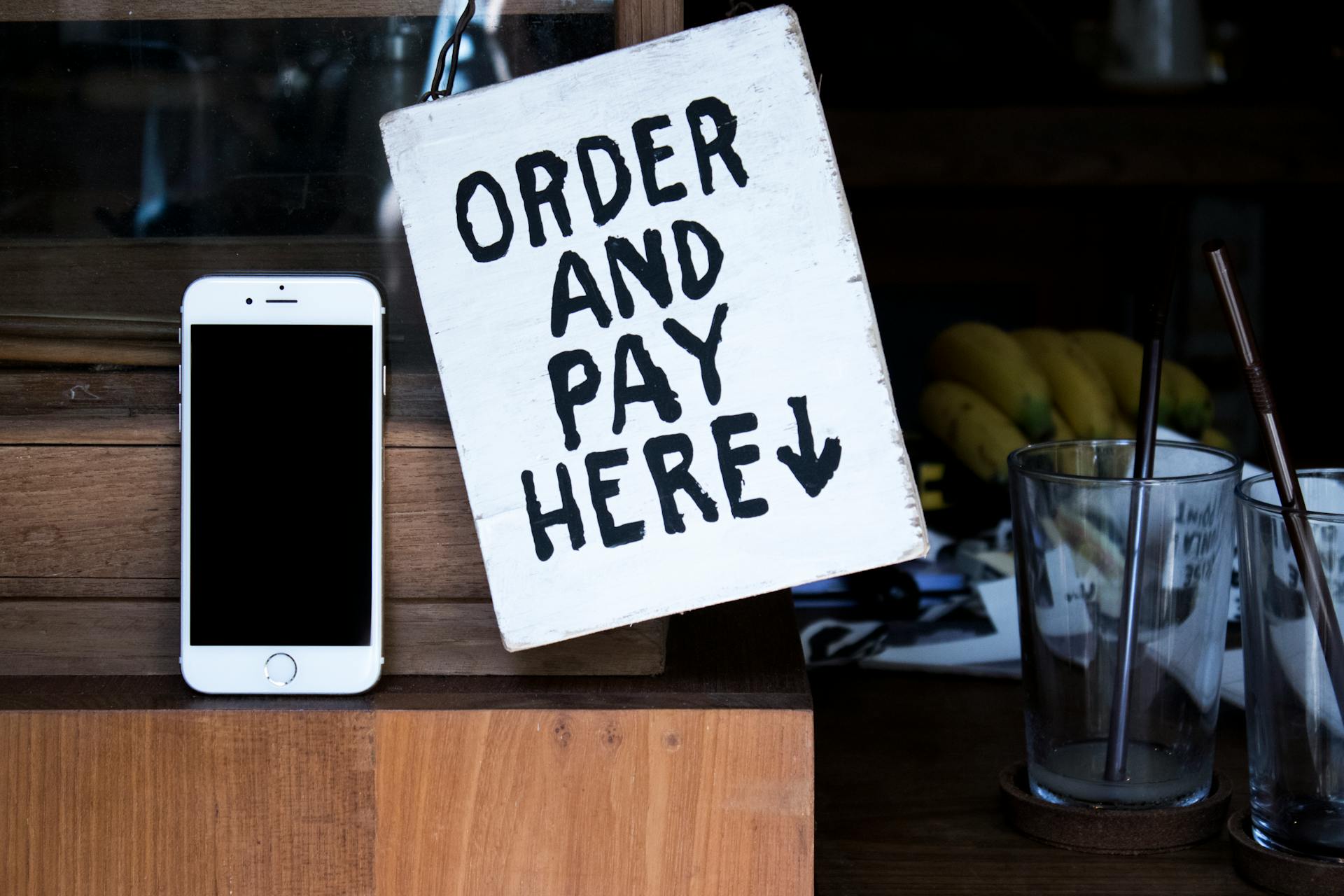
Shop Pay for Business is a game-changer for online retailers, allowing customers to pay for purchases directly at checkout without ever leaving the website.
With Shop Pay, customers can securely store their payment information, making future purchases faster and more convenient. This can increase conversion rates and reduce cart abandonment.
Shop Pay also offers a variety of benefits for businesses, including reduced payment processing fees and faster checkout times.
By integrating Shop Pay into their website, businesses can provide a seamless and streamlined shopping experience for their customers.
Consider reading: Accepting Credit Cards Can Be Useful to Small Businesses by
What is Shop Pay for Business
Shop Pay is a payment processing app built specifically for Shopify stores, and it relies on Shopify Payments or other third-party providers to process online store transactions. To use Shop Pay, you must first install Shopify Payments.
Shop Pay is exclusive to Shopify stores and only works with Shopify and Shopify Plus. It's a customer-facing checkout that allows customers to save their billing information for future purchases. Shop Pay will then use this information to automatically pre-fill the customer's checkout form for all subsequent purchases.
See what others are reading: Does Shop Pay Do Pay in 4
The app accepts American Express, MasterCard, Visa, and any other debit or credit card you support on your online store. Before users can use their payment cards with Shop Pay, they must first ensure their cards have been activated by their payment providers.
To opt-in to Shop Pay, users must check the "Remember me" option to save their information on the platform. This is only available to customers who sign up using their email address, not their phone number.
Shop Pay offers several benefits, including the ability to save up to 20 different shipping addresses and a maximum of 10 credit cards. Customers can also use Shop Pay Installments to purchase now and pay later.
Here are some key features of Shop Pay:
Benefits and Features
Shop Pay offers a range of benefits for businesses, including a faster checkout process that saves customers time and reduces frustration.
Faster checkout is one of the key benefits of Shop Pay, with the ability to arrange a payment in just 5 minutes.
For your interest: Benefits of Outsourcing Bookkeeping and Accounting
Shop Pay also saves customer information across all Shopify stores, making it a convenient option for repeat customers.
However, this convenience comes with a few drawbacks, including the requirement to use Shopify Payments and the limited language support offered by Shopify.
Despite these limitations, Shop Pay offers a range of features that make it an attractive option for merchants, including the ability to secure and encrypt customer information.
Here are some of the key benefits of Shop Pay:
By enabling Shop Pay as a client payment option, merchants can improve the customer experience and increase conversions, with Shopify claiming a 1.72 times greater conversion rate and 70% more efficiency than a typical checkout process.
Checkout and Payment Options
Shop Pay offers a seamless checkout experience, increasing conversion rates and checkout speed by 4 times compared to regular checkouts. This results in a 1.72 times higher checkout-to-order rate for stores using Shop Pay.
Shop Pay is only compatible with Shopify Payments, which is the payment option used by default by Shopify merchants. This means that retailers must have Shopify Payments activated for Shop Pay to function.
Consider reading: B2b Card Payments
Shop Pay accepts debit cards and all major credit cards, and also offers Buy Now Pay Later (BNPL) options, allowing customers to pay installments and spread the financial burden. This can encourage high ticket purchases and boost sales.
Here are some key features of Shop Pay's checkout and payment options:
Shop Pay Installments are available to US-based businesses that meet specific eligibility criteria and use both Shopify Payments and Shop Pay, offering two installment payment options: monthly installments or four interest-free installments every two weeks.
For another approach, see: Venture X Dallas - Braniff Centre
Checkout Customization
Checkout customization is a game-changer for online stores. You can tailor the checkout experience to make it unique to your business.
With Shop Pay, you can customize different aspects of the checkout process to determine how it looks and feels to customers purchasing from your store. This means you can offer perks like free shipping, express shipping, in-store pickup, and more to make your business stand out from the competition.
Explore further: Find Paypal Option on Shop Pay Checkout
You can also display specific items in your store to certain customers, share product recommendations, and even have a section where customers can view their past orders. This helps to create a more personalized experience for your customers.
Customization options include store contact methods, logo, cover image, description, and customer support options available to shoppers. This helps to establish a consistent brand image and build trust with your customers.
Here are some examples of customization options available with Shop Pay:
By customizing the checkout experience, you can create a more engaging and personalized experience for your customers, leading to increased loyalty and repeat business.
Faster, High-Converting Checkout
Shop Pay is considered one of the fastest and best-converting checkout experiences, increasing checkout speed by 4 times compared to regular checkouts.
In a study of the 10,000 largest Shopify stores with Shop Pay activated, Shopify found that stores using Shop Pay have an average checkout-to-order rate 1.72 times higher than those with regular checkouts.
Expand your knowledge: Stores That Accept Shop Pay Installments
On mobile, Shopify stores with Shop Pay have a 1.91 times higher conversion rate compared to regular checkouts, showing that Shop Pay provides a seamless experience to customers and helps store owners with higher conversion rates.
Shop Pay's faster checkout process is especially beneficial for customers who are eager to complete their purchases quickly. With Shop Pay, customers don't have to go through the hassle of filling out their billing information every time they want to buy a product from your store.
Here are some key statistics that highlight the effectiveness of Shop Pay's checkout process:
These statistics demonstrate the significant impact that Shop Pay can have on a store's checkout process and overall conversion rates.
Payout Schedule
When choosing a checkout and payment option for your online store, it's essential to consider the payout schedule. Shop Pay's payout schedule is quicker than PayPal's; typically, it may take only about three business days.
This can be a significant advantage for businesses that rely on timely payments to manage their finances.
Security and Trust
Security and Trust is a top priority for any online store, especially when handling sensitive customer information. Shop Pay integrates extensive security measures to keep customers' billing information safe from hackers and unauthorized entities.
Shop Pay uses two-factor authentication by sending an SMS verification code to ensure the account holder is the only person using the app. This added layer of protection is especially beneficial in today's data breach landscape.
Shop Pay's extra layer of protection can make it more challenging for shoppers to claim they never ordered a product, which is a plus for retailers. Shopify's PCI-compliant servers securely keep customers' information, providing an additional layer of protection.
Everything is encrypted, so customers' information is safe, and with over 1.2 million users, Shop Pay's popularity is on the rise.
On a similar theme: How Long to Keep Business Bank Statements
Security
Shop Pay's security features are designed to give customers peace of mind when making online purchases. The app uses two-factor authentication, sending an SMS verification code to ensure the account holder is the only person using Shop Pay.
Shopify's PCI-compliant servers securely keep customers' information, which is a huge advantage in today's data breach-filled world. This means customers' payment details are protected from hackers and unauthorized entities.
Shop Pay's extra layer of protection can also make it more challenging for shoppers to claim they never ordered a product. This is a plus for retailers, as it reduces the risk of chargebacks and returns.
Everything is encrypted with Shop Pay, ensuring customers' information is safe. With over 1.2 million users, Shop Pay's security features are clearly in high demand.
By using Shop Pay, customers can create a more secure transaction without submitting all of the required payment information. This saves them the hassle of going through the form-filling process, allowing them to check out within seconds.
Shop Pay's security is backed by Affirm and Shopify, two reputable platforms that prioritize customer trust. This means retailers can ride on the security of these platforms to build trust with their customers.
Here's an interesting read: Business Trust in India
Dispute Resolution Process
Shopify's dispute resolution process is designed to help merchants resolve issues with customers in a fair and timely manner.
For any issues with a purchase, the customer can open a dispute with Affirm, the company powering Shop Pay, if they're not able to get a resolution from the store owner.
To open a dispute, the purchase must have been made within the past 60 days.
After a dispute is opened, you and your customer have 15 calendar days to share evidence that supports your claim regarding the dispute.
Affirm will review the evidence from both parties and notify you and your customer about the decision within 15 calendar days.
In some cases, this process can take up to 90 calendar days for virtual card transactions.
Check this out: Shop Pay Affirm
Customer Experience and Loyalty
Faster checkout processes are a major turn-off for customers, with long-drawn-out processes causing them to change their mind at the last step.
By using Shop Pay, customers don't have to fill out their billing information every time they want to buy a product, making the checkout process much faster.
Shop Pay's custom product recommendations are specifically suited to customers' tastes, satisfying their craving for personalization.
This level of personalization is a win-win for both the customer and the business, as it enhances customer loyalty and encourages repeat business.
By offering an enjoyable checkout process, brands can enhance customer loyalty, making customers more likely to come back and buy again.
Suggestion: Customer Pay Shop Charge for Repair Order
Setup and Integration
To get started with Shop Pay, you'll need to enable it on your online store. This is a relatively straightforward process that takes no more than a few minutes to complete.
First, log in to your Shopify admin and click Settings > Payments. In the Shopify Payments section, select Manage and scroll down to Payments. From there, find Shop Pay and click the checkbox to select it, then click Save to save your changes.
If you're using a third-party payment gateway, you'll need to follow a slightly different process. Log in to your Shopify admin and click Settings > Payments, then navigate to the third-party payment provider's Payments section and select Manage. Find the Shop Pay section and click the checkbox next to Enable Shop Pay, then click Save to save your changes.
You might enjoy: How to Find Your Ein
You'll also need to complete the setup process, which involves clicking the Complete Setup button and inputting your store and banking details. Don't worry if you're not sure what this means - you have a 21-day grace period to complete this step, and any payments you receive from Shop Pay during this time will be reversed and automatically refunded to your customers.
To summarize, here are the steps to enable Shop Pay:
- Log in to your Shopify admin and click Settings > Payments.
- Find Shop Pay and click the checkbox to select it.
- Click Save to save your changes.
Keep in mind that you'll need to complete the setup process with your store and banking details within 21 days to receive payouts from Shop Pay.
Eligibility and Fees
To use Shop Pay, you need to have Shopify Payments enabled, which is automatically included for merchants with Shopify Payments. This is a requirement for all Shop Pay users.
Shop Pay is only available in certain countries, and even in the US, it's limited to online stores using Shopify Payments or third-party gateways.
See what others are reading: Is Shop Pay Shopify
Enabling Shop Pay itself doesn't cost any additional fees, but you'll still be charged the standard transaction fees for credit card payments, which vary depending on your Shopify plan.
You won't be charged third-party transaction fees for orders processed through Shop Pay, but if customers use Shop Pay Installments, you'll be required to pay a 5-6% fee on each transaction.
To use Shop Pay Installments, you must be based in the US, sell in USD, and have Shop Pay and Shop Pay Installments activated.
Here are some of the reasons your Shop Pay Installments account might be suspended:
- To access your online store, you need a password.
- Your online store’s main currency isn’t the USD.
- English isn’t your online store’s main language.
- There isn’t an internet website for your store.
- Your company offers services largely to other businesses (B2B).
- Your company provides financial services, gaming, or some other type of service that Affirm does not support.
- You market regulated goods like cigarettes, alcohol, and drug paraphernalia.
- You’re selling illegal goods like adult toys, money, or guns.
Comparison and Alternatives
Shop Pay for Business offers a competitive alternative to traditional payment methods, with a 0% interest rate and no fees for customers. This can help businesses save on transaction costs.
Some businesses may find that Shop Pay's 24-hour payment processing time is too long, especially for those that need to make same-day payments. However, this can be mitigated by using Shop Pay's instant payment option for an additional fee.
For businesses that want to avoid the 1.5% transaction fee, alternative payment methods like PayPal or Square can be considered.
See what others are reading: Wise Business Account Opening Fee
Shopify Payments vs. Shopify
Shopify Payments is a payment processing feature built into Shopify that allows merchants to accept various payment methods, including credit cards.
To use Shopify Payments, you must first set up a Shopify account and then enable the feature, which becomes available once you've done so.
Shop Pay, on the other hand, is a payment processing app built specifically for Shopify stores, and it relies on Shopify Payments or other third-party providers to process online store transactions.
In other words, to use Shop Pay, you must first install Shopify Payments, making them not the same product, despite their similar names.
Shop Pay isn't a standalone platform, unlike other payment processing apps from third-party providers, and the only way merchants can leverage its full benefits is by using both Shopify and Shopify Payments.
By subscribing to Shopify's Premium Plan, you can use Shopify Payments and Shop Pay, unlocking the full potential of both features.
You might enjoy: Shop Pay Financing
Shopify Payments vs. PayPal
Shopify Payments vs. PayPal - which one is right for you?
Shopify Payments and PayPal are two popular payment options for online stores. Shopify Payments has 60 million users, while PayPal boasts 435 million users.
Shopify Payments offers a seamless and faster checkout experience, allowing customers to securely save their email, shipping, billing, and payment details for future purchases.
PayPal, on the other hand, offers a slightly lesser smooth customer experience, but still provides a secure way for customers to pay with their PayPal account or credit/debit card without sharing their payment details with the merchant.
Transaction fees for Shopify Payments depend on the region, but in the US, it's 2.9% of the transaction + a flat fee of $0.30 USD. Outside of the US, it's 4.4% of the transaction + a fixed fee depending on the currency.
PayPal's transaction fees also depend on the region, with a fee of 2.9% of the transaction + a flat fee of $0.30 USD in the US, and 4.4% of the transaction + a fixed fee depending on the currency outside of the US.
Explore further: Us Bankcard
If you're using Shopify Payments, you won't incur any additional fees for enabling it, but you'll pay the same transaction fees as Shopify Payments. However, if you're offering Shop Pay Installments, you'll need to pay a 5-6% fee for each transaction.
Here's a comparison of the two payment options:
In terms of safety and security, both Shopify Payments and PayPal are completely safe and offer excellent protection for merchants and customers.
Shopify Payments also offers excellent merchant support, with a payout process that takes only 3 business days. PayPal's merchant support is good, but the payout process takes 5-7 business days.
Overall, Shopify Payments and PayPal have their pros and cons, and the choice between them ultimately depends on your specific needs and preferences.
Readers also liked: What Is Shop Pay vs Shopify
Best Alternatives
If you're not sold on Shop Pay yet, take a look at these other payment management systems.
Shop Pay is a convenient payment option, but it's not the only one.
Apple Pay and Google Pay are two popular alternatives that offer similar features and benefits.
If you're already using a wearable device or a smartphone, you might find these options more accessible.
Some merchants may also offer their own payment management systems, such as Amazon Pay or Walmart Pay.
For another approach, see: How to Start an Asset Management Firm
Comparison of PayPal

PayPal is a well-established online payment system that has been around for a while. It's widely accepted and trusted by many users.
One of the key features of PayPal is its ability to act as a middleman between buyers and sellers, allowing for secure transactions without sharing financial information. This can be a big plus for users who want to keep their financial data private.
PayPal charges a fee for certain types of transactions, which can range from 2.9% + $0.30 per transaction for domestic transactions to 4.4% + a fixed fee for international transactions.
Readers also liked: Can You Pay in 4 with Shop Pay
Tracking and Performance
Shop Pay's performance tracking features analyze several aspects of your business, giving you insight into the frequency of purchases, shipping times, and conversion rates. This data helps you identify areas for improvement.
Shop Pay sends tracking messages to both customers and merchants at key stages of the order process, keeping everyone informed. These messages are sent when the order is processed, dispatched, and received.
The tracking messages include a tracking code, which helps customers stay up-to-date on the status of their order.
Broaden your view: Tracking Business Expenses for Taxes
Performance Tracking
Performance tracking is crucial for any online business. It helps you understand whether your business is growing, stagnating, or receding.
You can track your business's performance with powerful features that analyze several aspects of your business. Shop Pay offers insight into purchase frequency, shipping times, and conversion rates.
Shop Pay sends tracking messages to customers and merchants at key stages of the order process. These include when the order is dispatched and when the customer receives their order.
Notifications can be sent to customers during checkout to keep them informed every step. This helps build trust and ensures a smooth customer experience.
Here are some key performance metrics you can track with Shop Pay:
- Purchase frequency
- Shipping times
- Conversion rates
By tracking these metrics, you can identify areas where your business needs improvement and make data-driven decisions to boost your performance.
Automatic Transaction Logs
Automatic transaction logs can be a real game-changer for customers who shop online.
Customers often struggle to keep track of their purchases, especially when they shop both online and in-store. They may have to sift through their credit card statements to identify the various items they've bought.
This can be frustrating, especially if the statements don't provide transaction details, making it hard to distinguish between online and in-store purchases.
Expand your knowledge: Bank Transfer Swift Code
Help Center
If you're new to Shop Pay for Business, don't worry, we've got you covered. Learn more about Shop Pay’s accelerated checkout, which can help reduce friction and increase conversions on your website.
To get started with Shop Pay, you'll need to set up a Shop Pay account and link it to your business's checkout process. This will allow customers to save their payment and shipping information for future purchases.
Shop Pay's accelerated checkout is designed to make the checkout process faster and more convenient for customers. By saving payment and shipping information, customers can complete their purchases in just a few clicks.
By implementing Shop Pay on your website, you can improve the overall shopping experience for your customers. This can lead to increased customer satisfaction and loyalty.
Here's an interesting read: Website Flipping
Frequently Asked Questions
How do merchants get paid with Shop Pay?
Merchants get paid by Affirm through the same bank account used for Shopify Payments. Payouts are sent directly to this account, regardless of custom payout schedules.
What are the disadvantages of Shop Pay?
Shop Pay has limited international availability and may incur higher fees for customers and merchants in certain situations. Additionally, it doesn't support digital payment methods like crypto or gift cards.
How much does Shop Pay charge merchants?
Shop Pay charges merchants 5.9% + $0.30 per transaction for Shop Pay Installment purchases, which may be subject to change. This fee is controlled by BNPL partner Affirm.
Featured Images: pexels.com


